A heat pump is, essentially, an inverted cooling machine. Using electricity, the system generates heat, which is very welcome for greenhouse growers. During Strawberry Day, Erik Bax delved deeper into the system, which, when used correctly, he believes to be much more efficient than the popular e-boiler. "A heat pump is suitable for many situations. It helps provide a solution to the energy problem," says the Energy and CO2 Emission Advisor.
In his presentation on January 10, Erik briefly touched on some well-known political decisions. "Growers still have time now, but in two years, the situation will get serious." He is referring to the costs of gas usage, among other things. Strawberry growers sometimes face an extra challenge compared to other greenhouse producers. Strawberry greenhouses are often located in isolated places, not in greenhouse clusters with better infrastructure. Therefore, they can't just connect to a source of geothermal or residual heat. "If external heat sources are lacking, the heat pump quickly comes into play." This allows them to produce their own heat.
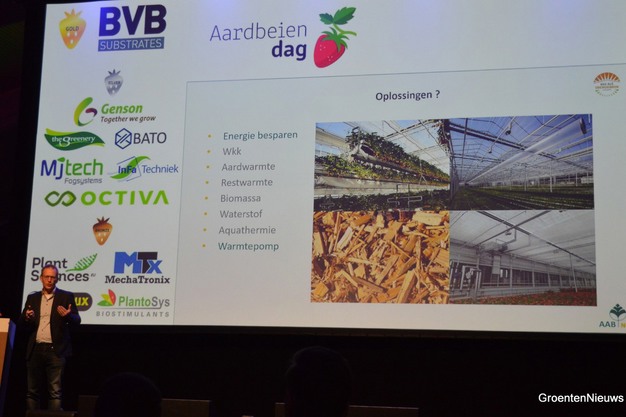
Erik Bax at Strawberry Day
Efficiency
A crucial condition for the use of a heat pump is the presence of an energy source. The system works on electricity. Moreover, an energy source is needed to 'harvest' the heat. This can be water, air, or residual heat. When harvesting heat, the COP value is important. The acronym, which stands for Coefficient of Performance, allows us to compare systems based on their energy performance. The COP value indicates the ratio between the electricity needed for the heat pump and the amount of heat it releases. "The higher the COP value, the more efficient the heat pump is."
It's important to use the heat pump correctly. If a user fails to do so, the system's electricity consumption quickly increases. "Watch out when the temperature difference between the evaporator and the condenser is too high." There are different types of heat pumps. Air-to-water heat pumps are often adapted to already existing environments. A disadvantage of this technique, according to him, is the lower COP value, which result in "it requiring more electricity, compared to a water-to-heat heat pump."
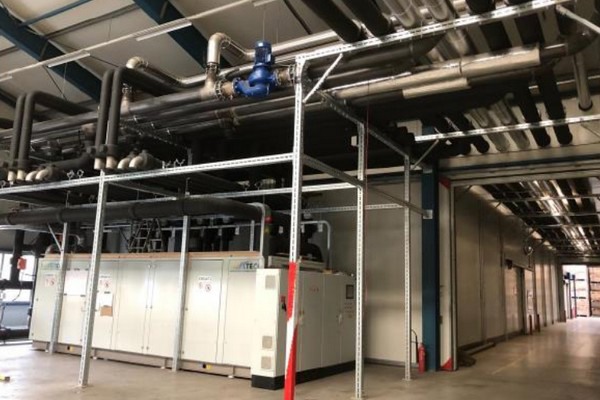 Water-to-heat heat pump used in horticulture
Water-to-heat heat pump used in horticulture
Comparison with boiler
During Strawberry Day, Erik illustrated with an example of how the system can work (graphical representation below). He did this for an electricity-powered compression heat pump, which generates heat equivalent to 1 cubic meter of gas with an input of 2 kilowatt-hours of energy. That cubic meter of gas is equal to 8.79 kilowatt-hours of heat.
Many strawberry growers still heat their greenhouses with gas-powered boilers. Erik explained how a heat pump becomes more profitable in the long run, partly due to new taxes. "In 2024, a heat pump is still more expensive, but by 2030, the balance will have tipped in favor of the heat pump. The tipping point is somewhere in between."
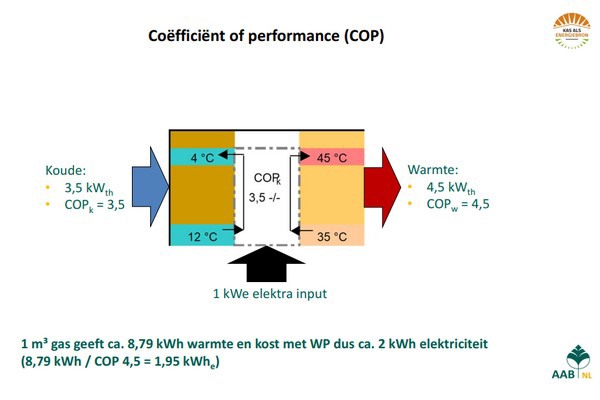
Operation of heat pump explained with a view to Coefficient of Performance (COP)
A heat pump is part of the solution
In horticulture, a heat pump is part of the solution. It combines well with other systems. Erik mentioned the combination with heat-cold storage at Van der Avoird Trayplant. With heat-cold storage, warm water at a temperature of up to 25 degrees Celsius is often allowed to stay in the ground. "A higher temperature would be better, but that's often not allowed in the permit."
When using heat-cold storage, it's important for growers to take a good look at their heating system. It must be suitable for low-temperature heat. In practice, this often means more heating pipes.
Another option is for the heat pump to be used in combination with aquathermy. Koppert Cress is a well-known user of this. In this case, the heat pump harvests heat from surface water.
Dehumidification is also often in the news with the rise of LED lighting. Some dehumidification systems also have a built-in heat pump, says Erik. He mentions the DryGair system as an example. "That's a kind of air-to-water heat pump."
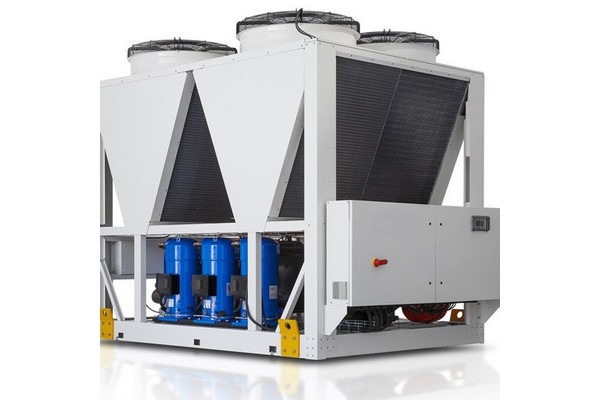
Example of air-to-heat heat pump. Erik doesn't have practical examples from horticulture yet.
Call to Action
Many growers won't be quickly convinced to install a heat pump, says Erik. Therefore, he believes that it's often wise to first critically examine a company's heat demand and reduce it where possible. This way, a potential heat pump can later cover a larger part of that heat demand. He calls for attempts to be made at getting a picture of the energy situation in the future. "It's good that growers have been given a bit more time to take measures."
For more information: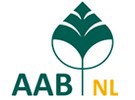
AAB NL
Honderdland Noord 1040, 2676 LV
Maasdijk, the Netherlands
Tel.: 0174 637637
info@aabnl.nl
www.aabnl.nl
